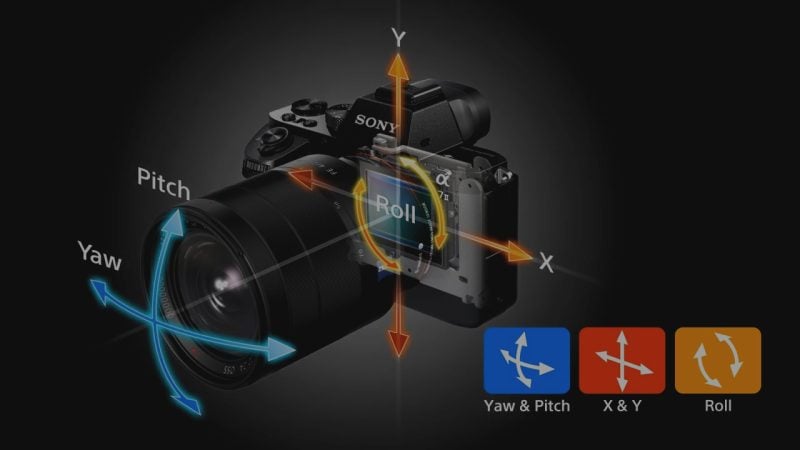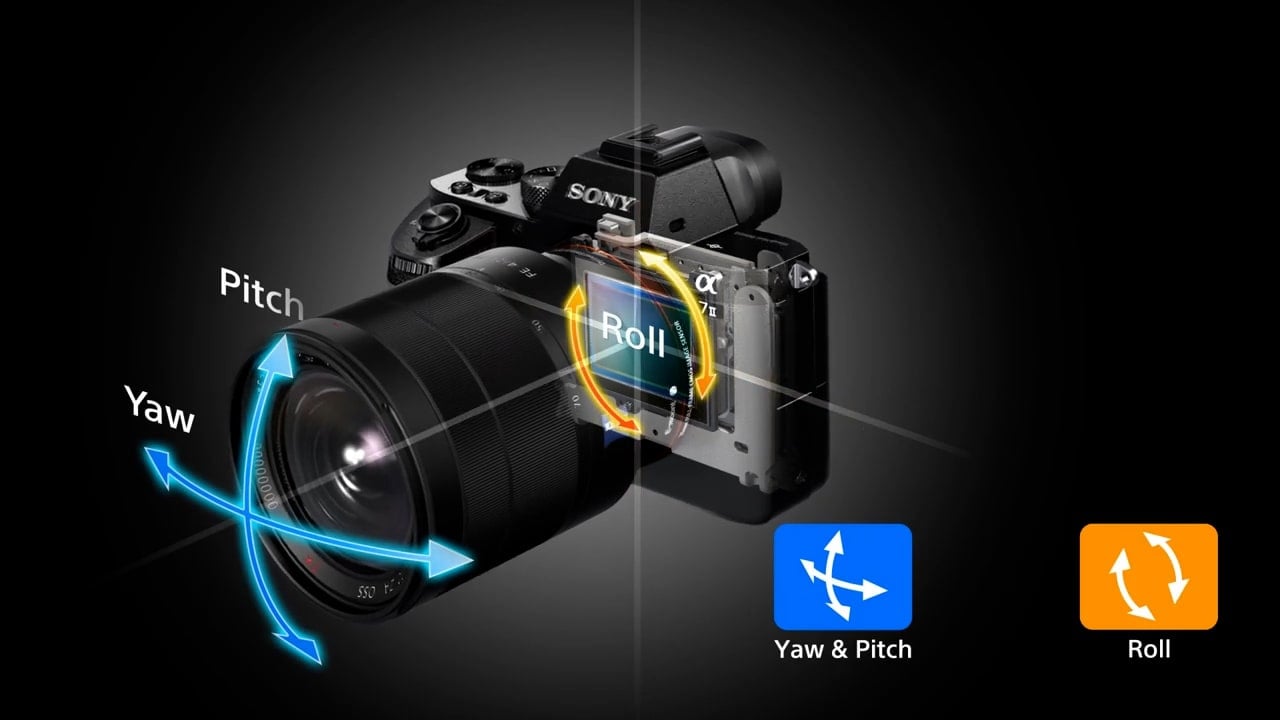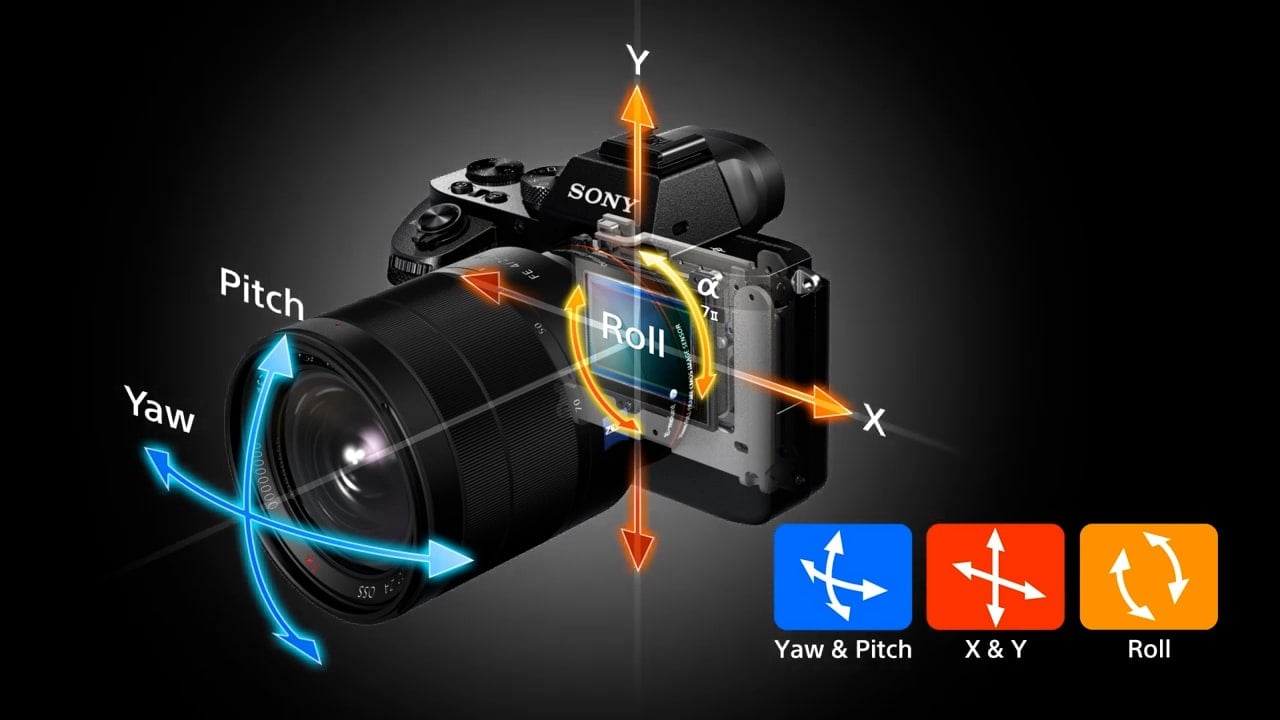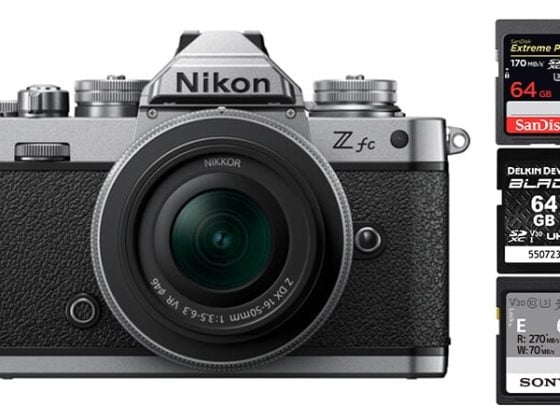With IBIS ( in-body image stabilization ) now a mainstream technology in our cameras, it’s time to talk a little bit about what’s going on behind the scenes, how it works, and what the difference between 5-Axis and 3-Axis IBIS really is.
Table Of Contents
3-Axis vs 5-Axis IBIS Which One Are You Using?
Not all cameras are 5-Axis IBIS capable, and just because your camera does have 5-Axis IBIS, doesn’t always mean it’s always being used.
Cameras like the Ricoh GRIII, or older Sony Alpha cameras only use a 3-Axis IBIS system.
Some third-party lenses and manual adapted lenses or older DSLR lenses will also only work with a 3-Axis IBIS.
What is 3-Axis IBIS?
3-Axis IBIS works with Pitch, Yaw, and Tilt only. This is very similar to how lens stabilization works. Just Pitch and Yaw.
3-Axis IBIS is what you get when adapting manual focus lenses or older lenses where the lens either passes the focal length electronically or where you set it manually.
If you’re using manual lenses with no electronic connectors, it’s important to set your focal length in the camera, so the system doesn’t over or under compensate.
What is 5-Axis IBIS?
In order for a camera to have 5-Axis IBIS, the lens must electronically pass not only the focal length but also the focus distance.
5-Axis IBIS will give you Pitch & Yaw, X & Y, and Rotation adjustments.
In order for X&Y to work correctly, the camera needs to know the focus distance since the subject being close to the lens will need a lot more correction than if the subject is at infinity where almost no correction is needed.
5-Axis stabilization at far distances on wider lenses offers pretty minimal advantages over the 3-Axis system which is why cameras like the Ricoh GR III are fine with just a 3-Axis system.
On longer lenses at closer distances, 5-Axis really shows an advantage since in these situations the horizontal and vertical movements are much more pronounced.
You can watch it in effect in this video by Sony. Notice they use a flower at a macro distance to demonstrate the X & Y adjustments of the 5-Axis system.
Adapted DSLR Lenses 5-Axis or 3-Axis IBIS?
Nikon has been very straightforward by warning users of the in-body image stabilization limitations of using F mount lenses on the Z mount bodies.
Currently, if you adapt F-Mount lenses to Z bodies, you will only get 3-Axis in-body stabilization.
Why?
Because F-Mount lenses never needed to pass focus distance because they’ve never had IBIS before.
Canon EF lenses to RF mount have a similar issue which is why some people report Canon EF lenses not working quite as well as RF lenses with IBIS. Likely there just isn’t hardware there to record focus position.
Do Third-Party Lenses Use 5-Axis or 3-Axis IBIS?
Here is where things get tricky. A lot of people love the idea of adapting third-party lenses, especially the Sony community, but it’s just not clear what lenses are fully configured for 5-Axis IBIS or not.
It’s probably safe to assume and DSLR lens adapted to mirrorless will only use 3-Axis IBIS, possibly even including many of the Sigma or Tamron lenses that were original DSLR designs that have been converted.
With camera brands, often the lens protocols are not being officially used and it’s unknown what information is being passed to the camera.
For example, with the Sony E-Mount, I’ve heard the Loxia lenses have electronic contacts and pass focal distance automatically, but do not pass focus distance so with these lenses you only get 3-Axis IBIS. I can’t verify this, it’s just an example and something to look for.
The Voigtlander lenses designed for the Sony E-Mount do pass focus distance and do give you 5-Axis IBIS.
Zeiss says their Batis lenses are 100% compatible with the Sony E-Mount so I would have to assume they also have 5-Axis IBIS. This is likely the case with the new Mirrorless designed Sigma and Tamron as well.
So it’s not clear if all third-party lenses use 3-Axis or 5-Axis. But any lens without electronic contacts will only use 3-Axis.
How To Know If You’re Lens Is Using 5-Axis IBIS?
If your lens is passing focus distance, then the camera can use that data and activate the X & Y corrections, giving you full 5-Axis IBIS.
To see if your lens is passing focus distance, you have to search the metadata in something like RAW Digger.
If the information on the focus distance is correct and being passed onto the camera, it should be in the metadata and the camera should be able to use this for X & Y correction giving you 5-Axis support.
How Lens Stabilization Works With IBIS
Lens stabilization synchronizes with IBIS a little differently in every camera, so this isn’t a straight and easy answer.
Typically a lens VR, OSS, IS, or OIS will take over the Pitch and Yaw from the IBIS since the lens is much better at doing this and the sensor-shift will just correct for doing Y, X, and Rotation.
In some cameras like with the Canon RF system or in some Panasonic cameras, the IBIS can work together with the Imagine Stabilization of the lens. Panasonic calls this Dual I.S. or Dual I.S.2.
Instead of just turning off Pitch and Yaw on the sensor movements, the lens will sync with the sensor adjustments and they both work together for improved results.
When IBIS Is Important
You’ve probably seen reviewers go out to compare cameras, and they try to see which camera can shoot the slowest shutter possible.
This is not why IBIS is important but just one of the benefits you can get out of the IBIS system. I used to think I never needed IBIS because I never tried to shoot 2-second shots handheld.
It wasn’t until I started using IBIS regularly that I noticed its benefits. It really helps at your typical or casual shutter speeds, 1/60 – 1/200.
Even handheld sometimes you’ll shake when triggering the shutter, or maybe you’re shooing while still moving or walking. In these situations, without IBIS, you’ll often see camera shake motion blur even at higher shutter speeds. IBIS does a great job at eliminating that.
It’s especially nice just to get a stable image when it comes to framing up a shot, especially on a longer lens, and especially a long lens shooting macro photography.
IBIS is also great for casual video, but any serious professional should not depend on it since it’s less than perfect and does introduce a lot of hitches.
I do also shoot a lot without IBIS and it’s not really a huge problem for street shooting or casual shooting. On my X100V I just try to keep the shutter at around 1/160 and I’m usually fine for street shooting, but if I had IBIS I would probably shoot more in the 1/80 to 1/100 range on a 35mm lens unless I needed to freeze the subject matter.
Are Some IBIS Systems Better Than Others?
There have been now several tests showing a difference in the camera’s IBIS systems performance.
Here in The Digital Picture compared the Sony A1 to the Canon R5.
Overall the Canon R5 had about a 30% advantage over the Sony A1.
Canon In-Body Stabilization Better Than Sonys
Nikonrumors here shares with us a report from a magazine that compared various IBIS and lenses VR systems.
It’s unknown really how scientific these tests were, so don’t take them as gospel.
From their tests, the Nikon Z7 II produced the highest “Very Good” results, and the Olympus produced the most usable results at slower shutter speeds, followed by Canon and then Panasonic.
Based on their findings, for very slow shutter photography of 1.5 and 2 seconds, Olympus and Canon produced the best results.
For stabilization at just slow speeds, Nikon produced the best results.
Then for common shutter speeds, they all produced good results, although it would be interesting to see how they perform under different magnitudes of shake.
Which Cameras Have The Best IBIS?
This is not a clear-cut question to answer because each system will have strengths and weaknesses.
If using wider lenses where the X & Y corrections are not engaged the advantage gap Canon has over Sony could close and both systems could perform similarly.
Some lenses with stabilization paired with the IBIS will also likely have better results. For example the Canon 35mm IS is very effective whereas the Nikon 35mm does not have any vibration reduction so will have to completely depend on the sensor stabilization.
Currently, based on all the comparisons from the German Foto Magazin, the ranking goes something like this.
Best IBIS System By Rank
#1 Canon / Nikon – Each system had strengths and weaknesses. For the full-frame systems, Canon produced better extreme slow shutter results, Nikon produced better slow shutter results. Although from my experiences with Nikon, their cameras have a slow drift with the IBIS system if your hands are very steady, introducing more shakes, actually stops this drift and improves performance. It’s weird.
#2 Olympus – Olympus with its micro-four-thirds sensor produced the best results at very slow shutter speeds. Meaning you could consistently get keepers with 2-second exposures. The smaller sensor likely isn’t as affected as much by the earth’s rotation, which is actually a limiting factor on these IBIS systems.
#3 In a close second with the full-frame is Panasonic. Slow shutter performance wasn’t quite as good as Nikon and the extreme slow shutter wasn’t as good as Canon. It would be difficult to tell the difference between Canon / Nikon and Panasonic in real-world use.
#4 Fujifilm came in a fourth position with the X-T4 which uses an APS-C sensor. It’s unknown if the X-H1 has better IBIS than the X-T4 or how well the GFX system performs. Fujifilm did make the X-T4 IBIS system overall smaller.
#5 Sony’s full-frame system comes behind Fujifilm’s APS-C system scoring in the last place. It’s not really known why Sony’s IBIS isn’t on par with the other camera brands, some say it’s because they’re using an APS-C mount in front of a full-frame sensor and there just isn’t enough room for the sensor to move around based on the angles the light has to hit the sensor at.
It’s not known if Sony’s APS-C system is better or not. But from my experience with the A6600, it’s better.
Does it Really Matter That One Camera Is Better At IBIS?
Yes and no and this is now my personal experience.
The three cameras I shoot with today are the Fujifilm non-IBIS cameras, X-Pro2, X-T3, X100V.
With IBIS I Shoot with the Nikon Z6 and the Sony A7rIII.
For Stills
I find on Fujifilm when shooting street photography I need to work with a higher shutter speed to cut out camera shake. Even 1/100 will show camera shake on the Fujifilm system, whereas it’s a lot more subdued on the Nikon or Sony systems with stabilization. Some of that has to do with APS-C just showing more flaws in general. It would be like always cropping in on my A7rIII, where any motion blur, dust on the sensor or lens, or CA will be slightly more magnified.
On my X100V with the wider lens, I typically don’t feel like I’m missing out too much on IBIS but I still can tell it’s missing.
The Nikon Z6 IBIS is very noticeable, where on the Sony it’s not as obvious it’s on and working. Which, doesn’t mean it’s not working.
I don’t feel like my Sony images are getting hit with a lot of camera shake motion blur like I experience with non IBIS cameras even though it’s a subtle IBIS system. Shooting street photography I don’t see an obvious difference between Sony or Nikon with my images. The camera shake is usually neutralized at the shutters speeds I often use which are usually pretty high, 1/100 – 1/160 at least.
Whereas I can see the motion blur from time to time on my non-IBIS camera even the full-frame Canon R at the higher shutter speeds I like shooting at.
So I wouldn’t really worry about the above scores if you’re a Sony shooter shooting casual photography. I don’t really see a difference between the Z6 and A7rIII in real-world shooting.
Often when I drop to slower shutter speeds it’s usually for more effects shooting where a 30% difference in IBIS performance won’t really matter, like with this shot, shot on the Fujifilm X100V at 1/15 shutter with no IBIS.
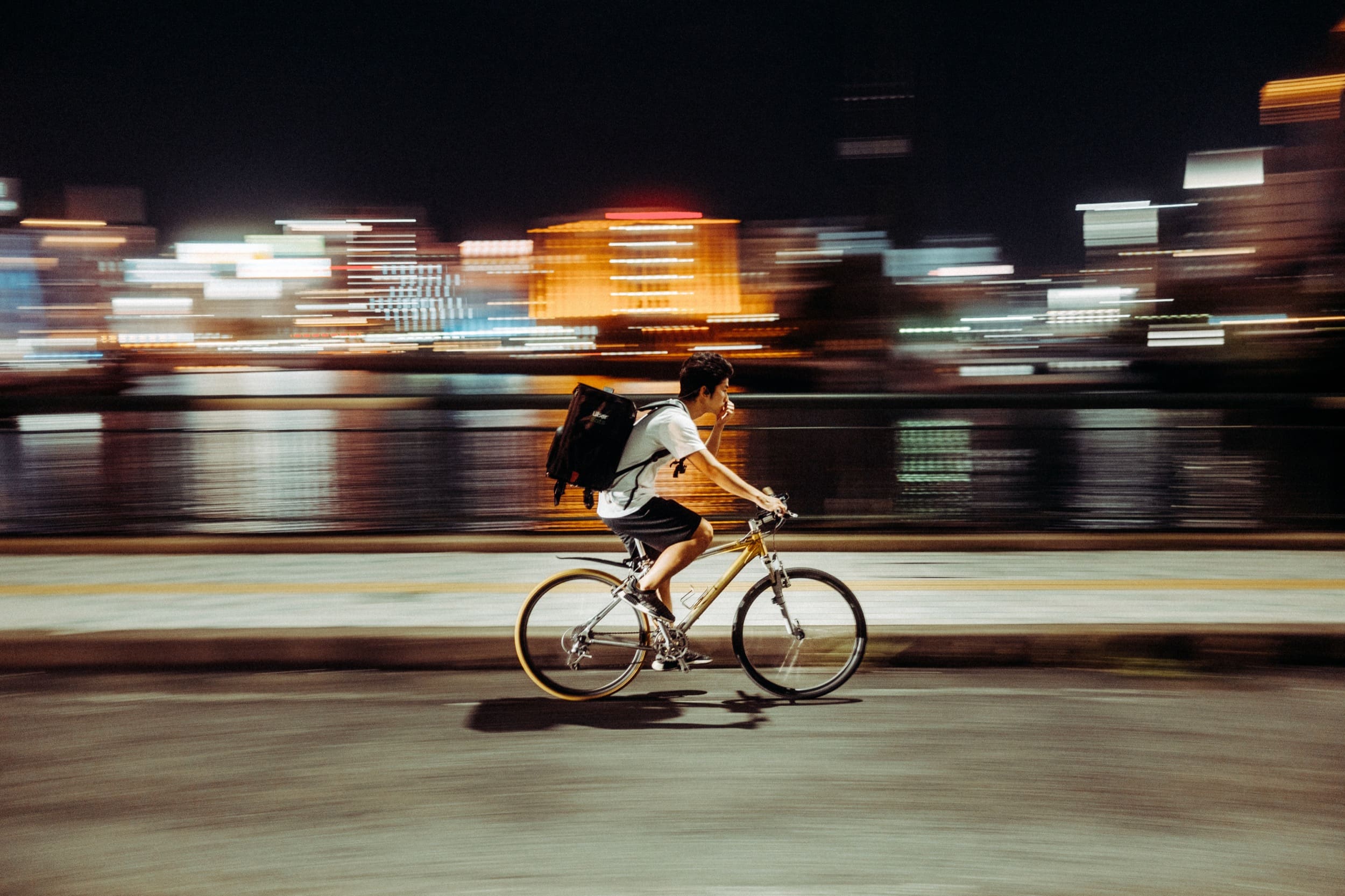
When dealing with extremely slow shutter speeds, I will see the difference between Sony and Nikon. Of course, this depends on if you’re using a VR, or OSS lens or not as well.
Occasionally if you’re shooting travel photography you’ll find yourself in a place that doesn’t allow tripods, then having extra stabilization is useful. So if you’re on Sony or Fujifilm, just make sure you have a good lens with good OSS. I get by with my Canon R (non IBIS camera) with the 24-105mm IS without any problems in these situations.
Or burst several shots because only some will be perfectly detailed even on the best IBIS system out there. So even if a Sony or Fujifilm is less perfect than a Canon or Nikon, you can compensate for this by just burst a few more shots and you can still get keepers.
For Video
I’ve gone back and forth between my Sony and Nikon to find which is best for video for run and gun shooting, and I personally just like the Nikon Z6 more, primarily for the IBIS. It works very well. Plus the AF on the Nikon is easier to adjust on the fly, but that’s a different topic all together.
But there is a catch. The Nikon Z6 will hitch a lot harder if your camera is moving around, and the Nikons do allow small drift in the motion of the IBIS if you hold the camera fairly steady. If you add more shake the system locks tighter.
Sony introduced a firmware in late 2018 that changed the IBIS in the A7rIII and it doesn’t really allow drift as much. It now always tries to do a hard lock to make the image totally still, and I feel like this made it worst for video since you can feel it break more often from the stable position, whereas before it would drift around a bit more naturally.
When moving around and shooting somewhat sloppy, the hitches on the Sony A7rIII are overall not as big or as noticeable as with the Nikon, but the system is overall less stable. So if you’re doing a lot of big motion, walking, and moving with the camera, the Sony has more shake, but it feels less interfered with than the Nikon that tries to go steady, then breaks, steady then breaks. The Sony can give you a more natural handheld look.
But there are so many ways to configure your cameras today with gimbals or extra grips, any big advantage one brand has over another can be compensated for with some improved technique or accessories, or warp stabilizers in post-production or digital stabilizers in the camera body.
Just be careful about using digital stabilizers on video if you’re shooting at slow shutters like 1/48 since you can still see motion blur streaks even though the image is still.
| **This website contains affiliate links. We will earn a small commission on purchases made through these links. Some of the links used in these articles will direct you to Amazon. As an Amazon Associate, I earn from qualifying purchases. |

